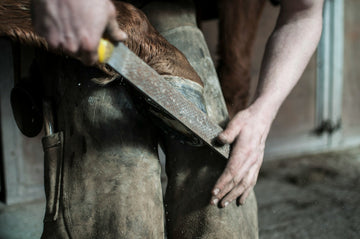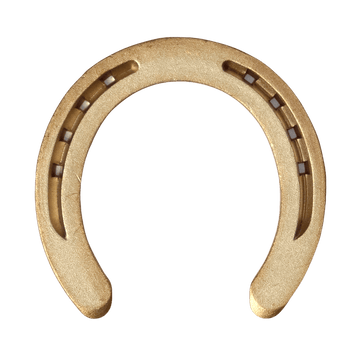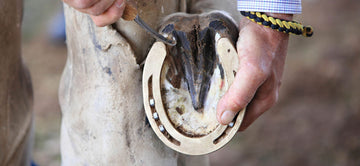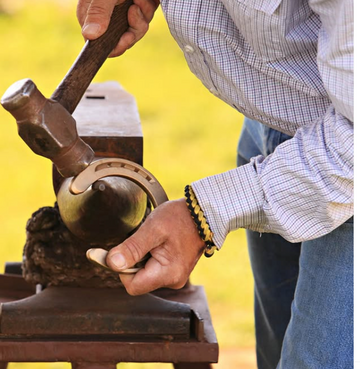Domesticated horses are essential for many domestic horses, providing protection and support to their hooves.
But why do horses need them, and what benefits do they offer?
This article explores the history, purpose, and maintenance of horseshoes, as well as their role in modern equine care.
What Are Horseshoes?
Horseshoes are U-shaped plates made from materials such as steel, aluminum, titanium, copper, rubber, or synthetic composites.
These shoes are typically attached to the underside of a horse’s hoof to provide protection and improve functionality, as the horse hoof is designed for optimal function and protection.
Key Features of Horseshoes
-
Material Diversity: While steel and aluminum are common, modern horseshoes are also crafted from lighter or specialized materials for specific purposes.
-
Traction Enhancement: Fullering grooves or textured surfaces may be added to improve grip, especially for working or sport horses.
-
Customized Fit: Horseshoes are tailored to each horse based on its breed, age, hoof size, and intended use.
-
Specialized Shoes: For horses with specific hoof disorders or abnormalities, specialized shoes or corrective measures are necessary to provide relief and support. Collaboration between the farrier and veterinarian is crucial in these situations.
Horseshoes are most often applied using nails, though adhesive or clip-on options exist for certain scenarios.
Materials Used in Horseshoes
Horseshoes are crafted from a variety of materials, each offering distinct advantages tailored to the needs of different horses and their activities. The most common materials include:
-
Steel: Steel horseshoes are the traditional choice, known for their strength and durability. They are versatile, available in numerous styles and sizes, making them suitable for a wide range of horses and activities.
-
Aluminum: Lighter and more flexible than steel, aluminum horseshoes are favored for racing and performance horses. Their reduced weight can enhance a horse’s speed and agility, making them ideal for competitive environments.
-
Copper: A newer addition to the horseshoe market, copper shoes are praised for their antimicrobial properties, which can promote healthy hoof growth and reduce the risk of infections.
-
Rubber: Rubber horseshoes provide excellent cushioning and support, making them a good option for horses with sensitive hooves or those prone to hoof problems. They are often used for therapeutic purposes.
-
Plastic: Lightweight and easy to clean, plastic horseshoes are suitable for horses engaged in light riding or driving. They offer a balance of flexibility and support, ensuring comfort for the horse.
In addition to these primary materials, horseshoes can be enhanced with various additives and coatings to improve their performance and longevity.
For instance, some shoes are coated with tungsten carbide to increase wear resistance, ensuring they last longer even on challenging surfaces.

History of Horseshoes
The origin of horseshoes is deeply tied to the domestication of horses. Early humans recognized the need to protect horses’ hooves as they transitioned from wild to working animals.
-
Ancient Beginnings: Evidence suggests that crude forms of hoof protection, such as leather or woven materials, were used before the development of metal shoes.
-
Roman Influence: The Romans are credited with early advancements in horseshoe technology, using iron plates to protect their cavalry horses.
-
Modern Evolution: Horseshoes have become more specialized, evolving alongside equestrian sports, working horses, and veterinary medicine. A horse that wears shoes is referred to as a 'shod horse', in contrast to an 'unshod' or barefoot horse.
Horseshoes remain a vital tool in equine care, providing the protection needed for horses working in environments far removed from their natural habitats.
Why Do Horses Wear Shoes?
Horses wear shoes for several reasons, ranging from protecting a horse's foot to providing therapeutic support.
Protection and Durability
-
Horseshoes safeguard a horse's feet and hooves from excessive wear, particularly for horses that work on hard or abrasive surfaces.
-
They prevent injuries caused by sharp objects or uneven terrain.
Therapeutic Use
-
Horseshoes can help alleviate hoof pain or support horses with conditions like laminitis or navicular disease, significantly improving a horse's hoof health.
-
Specialized therapeutic shoes are designed to address specific hoof abnormalities or injuries.
Enhanced Performance
-
Horses used in racing, jumping, or other sports often wear shoes to improve traction and performance.
-
The concept of a horse wearing shoes, or being 'shod', is crucial for distinguishing between a 'shod horse' and an 'unshod' or 'barefoot' horse, emphasizing the significance of horseshoes in facilitating the horse's work and overall hoof health.
-
Certain designs cater to the demands of high-impact activities, reducing stress on the hooves and legs.
Shoes not only protect but also enhance a horse’s capabilities, ensuring comfort and safety during demanding tasks.
The Role of a Farrier
A farrier is a trained professional specializing in the care and maintenance of horse hooves. Their expertise is critical in ensuring the health and comfort of a horse’s feet.
Responsibilities of a Farrier
-
Trimming Hooves: Regular trimming ensures the hooves remain properly shaped and balanced.
-
Fitting Horseshoes: Farriers assess the horse’s needs and adapt prefabricated horseshoes to fit precisely. They are responsible for removing, inspecting, and replacing the horse's shoes, using different methods based on the horse's activity and terrain.
-
Hoof Health Management: They identify and address potential issues, such as cracks or infections.
Farriers work closely with horse owners to develop a care schedule tailored to the horse’s activity level and health.
Horseshoes and Horse Health
Horseshoes contribute significantly to the overall health and functionality of a horse's hoof.
Benefits of Horseshoes
-
Traction Improvement: Shoes help shod horses maintain grip on slippery or uneven surfaces.
-
Injury Prevention: They shield the hooves from excessive wear and external hazards.
-
Therapeutic Support: Horseshoes can relieve pressure on injured hooves, aiding in recovery.
Maintenance Schedule
Shoes typically need to be reset every six to eight weeks, and it is crucial for the horse owner to be involved in this process. During this time, the farrier trims the hooves, assesses their health, and applies new or adjusted shoes.
Can Wild Horses Go Barefoot?
Wild horses, often referred to as barefoot horses, maintain their hooves naturally due to constant movement across diverse terrains.
Why Wild Horses Don’t Need Shoes
-
Natural Wear: Continuous movement over abrasive surfaces keeps hooves naturally trimmed and strong. Unshod horses, particularly those living in soft environments, may not exercise enough to adequately wear down their hooves, potentially leading to management issues.
-
Environment Adaptation: Wild horses have evolved to thrive in their specific habitats.
Domestic Horses vs. Wild Horses
Horses need shoes because domestic horses often require them due to their environment and workload. Unlike wild horses, they may be exposed to hard, artificial surfaces or repetitive activities that necessitate additional protection.
Horseshoe Maintenance
Proper maintenance of horseshoes is vital for the health of horses' feet.
Resetting Horseshoes
-
Regular Removal: The farrier removes old shoes, trims excess hoof growth, and reshapes the horse's hooves as needed.
-
Inspection: Hooves are examined for signs of wear, cracks, or infection.
-
Reapplication: Adjusted or new shoes are fitted to ensure comfort and functionality.
Long-Term Benefits
Domesticated horses benefit greatly from routine horseshoe maintenance, which helps prevent issues like uneven hoof growth, lameness, and discomfort, ensuring the horse remains sound and healthy.
Innovations in Horseshoe Design
Recent advancements in horseshoe design have significantly improved the comfort, performance, and durability of horseshoes, addressing the evolving needs of modern equine care. Some notable innovations include:
-
Glue-on Horseshoes: These horseshoes are attached using a special adhesive, providing a secure fit without the need for nails. They are particularly beneficial for horses with sensitive hooves or those prone to hoof problems, offering a gentler alternative to traditional shoeing methods.
-
Polyflex Horseshoes: Made from a flexible plastic material, Polyflex horseshoes offer superior cushioning and support. They are designed to adapt to the natural movement of the horse’s hooves, reducing stress and promoting hoof health.
-
Horseshoes with Built-in Traction: To enhance grip on slippery or rough terrain, some horseshoes now come with built-in traction devices like studs or cleats. These are especially useful for trail horses or those working in challenging environments, providing extra stability and safety.
-
Antimicrobial Horseshoes: Incorporating antimicrobial properties, these horseshoes help promote healthy hoof growth and prevent infections. They are ideal for horses with a history of hoof issues or those kept in environments where hoof health is a concern.
These innovations reflect the ongoing efforts to improve equine care, ensuring that horses can perform at their best while maintaining optimal hoof health.
Benefits of Horseshoes for Horse Hooves
Horseshoes offer numerous advantages for a horse's hooves, especially for horses that perform a variety of tasks:
-
Hoof Protection: Shields hooves from wear and tear on challenging surfaces.
-
Weight Distribution: Promotes even weight-bearing, reducing the risk of hoof-related conditions like laminitis.
-
Traction Enhancement: Provides stability on slippery or rocky terrain.
-
Therapeutic Applications: Specialized designs support horses with injuries or hoof deformities.
Shoes allow horses to perform in ways they couldn’t naturally, helping them adapt to domesticated and competitive environments.
Importance of Regular Trimming
Trimming is a cornerstone of hoof care, ensuring that a horse's feet and hooves remain healthy and functional.
Benefits of Trimming
-
Prevents Overgrowth: Excessive hoof growth can lead to discomfort and imbalance.
-
Shapes Hooves: Proper shaping promotes even weight distribution and natural movement.
-
Reduces Risk of Problems: Regular trimming helps prevent issues like quarter cracks, low heels, and winging, which are crucial for maintaining a horse's hoof health.
Even horses that go barefoot benefit from routine trimming to maintain optimal hoof health.
Environmental Impact of Horseshoes
The environmental impact of horseshoes is an important consideration for responsible horse owners. Horseshoes, particularly those made from metal, can contribute to environmental issues if not managed properly. Key concerns include:
-
Metal Waste: Discarded horseshoes can add to metal waste if they are not recycled. This waste can accumulate in landfills, contributing to environmental pollution.
-
Resource Depletion: The production of horseshoes requires natural resources like iron and steel. Unsustainable extraction of these materials can lead to resource depletion and environmental degradation.
-
Pollution: Improper disposal of horseshoes can result in pollution. For example, metal horseshoes can leach heavy metals into the soil and groundwater if they end up in landfills.
-
Habitat Disruption: Discarded horseshoes in natural areas can harm wildlife and disrupt ecosystems, posing a threat to biodiversity.
To mitigate these impacts, horse owners can take several proactive steps:
-
Recycling Horseshoes: Many farriers and blacksmiths offer recycling programs for old horseshoes. Participating in these programs helps reduce metal waste and promotes sustainable practices.
-
Using Eco-friendly Horseshoes: Some horseshoes are now made from recycled materials or bioplastics, offering a more environmentally friendly option.
-
Proper Disposal: Horse owners should dispose of horseshoes in designated metal recycling bins or take them to local recycling centers to ensure they are processed correctly.
-
Reducing Waste: Opting for durable horseshoes with built-in traction devices can extend the lifespan of the shoes, reducing the frequency of replacements and minimizing waste.
By adopting these practices, horse owners can contribute to a more sustainable and environmentally friendly approach to equine care.
Frequently Asked Questions
What is the point of horseshoes?
Horseshoes protect a horse's foot from wear and tear, provide traction, and can be used therapeutically to address hoof issues.
Why do wild horses not need horseshoes?
Wild horses naturally wear down their hooves through constant movement over rough terrain, eliminating the need for shoes.
How do horseshoes not hurt the horse?
Horseshoes are attached to the insensitive part of the hoof, much like trimming fingernails, so the process is painless when done correctly.
How did horses survive before horseshoes?
Before horseshoes, horses relied on natural wear and genetic adaptation to maintain hoof health, which was sufficient in their natural environments.
What Are Horseshoes For Conclusion
Horseshoes are an essential tool in modern equine care, offering protection, support, and therapeutic benefits.
By understanding their importance, horse owners can make informed decisions about hoof care.
Regular trimming, shoeing, and collaboration with a skilled farrier are crucial for preventing hoof problems and ensuring the horse remains sound and comfortable.
Proper hoof care is a key factor in promoting a horse’s overall health and well-being, enabling them to perform and thrive in any environment.










